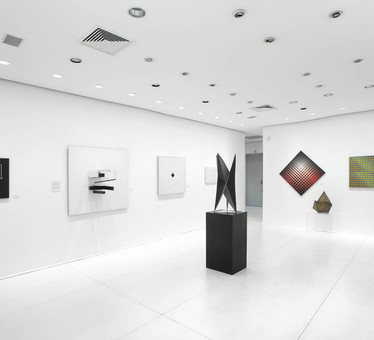Concretos Paralelos

Collective Exhibition
São Paulo, Brasil
06/09/2012 - 04/11/2012
Cultura Inglesa São Paulo holds an unprecedented exhibition both in Brazil and abroad, opening on September 3 at the Brazilian British Center / Cultura Inglesa. The show is part of the UKBrasil season’s activities calendar and the GREAT campaign, an initiative of the UK government to expose the best of British business, culture, science and innovation in Brazil, giving rise to new and long-lasting partnerships.
The purpose of this exhibition, which takes place concurrently with the 30th Bienal de São Paulo, is to highlight the parallels between British constructivist artists and Brazilian concrete artists during the period 1955-1975 / 80. Both movements emerged at the same historical moment, were influenced by the same artists and critics, and shared the same pioneering aspiration to modernism and reconstruction in their countries. In doing so, they chose the same art form. Both saw their work as an element of a broader social creative dynamic that extended to architecture, design and poetry. Although this parallel is very clear today, it has never been explored in an exhibition or publication with this scope.
The same group of artists will be presented in an independent exhibition by Dan Galeria, in the context of its tradition of Constructive art exhibitions, opening on September 5.
Constructivist seeds in art emerged at various fertile moments in art history, such as in post-World War II art. The great masters, artists and students of the Bauhaus then dissolved by Nazism spread and spread their theories around the world. Part went to England, where, at the beginning, his works did not have much repercussion in terms of audience, still very conservative in relation to the old schools. In the post-war, with the expansion of industrial production, serialization and rationalization of production, and already under the influence of the Ulm school, European vanguards began to discuss the insertion of the machine in society, with attempts to unite art and industry. . The use of the combination of different welded materials became the most used sculptural method.
Although we identified its roots in the first modernist manifestations of the 40’s, mainly in the works of Waldemar Cordeiro, Abraham Palatinik and Geraldo de Barros, this constructivist line arrived in Brazil in the early 50’s, almost contemporary to the founding of Ulm, mainly through Max Bill, who made his first exhibition in Brazil in 1949. It is therefore not a coincidence, historically speaking. The Säo Paulo Biennial started in 1951 and exhibited mostly concrete and abstract works. The award for the sculpture Max Bill’s Tripartite Unit at this Bienal and an atmosphere of optimism from the “golden years” with its promises of development and modernity contributed to further instigate Brazilian artists who identified with concrete art.
The neo-concrete movement, born in Brazil around the 1960s, emerges as a reaction to the rationalist concretism of exploring optical illusions, re-approaches the Russian avant-garde in the search for a new object for art, making more use of subjectivity and the body than objectivity and reason. Brazilian neoconcretism no longer deals with the problem of representation to any degree, but with that of lending a transcendence to the canvas itself as a material object, according to Ferreira Gullar (1985). Probably his greatest legacy was to relate art to science and technology. The rational approach inspired not only kinetic sculptures, minimalism, concrete painting (which seems to be done by machine), geometric abstraction and technological art.
This overall reading of English constructivism in contrast to Brazilian concrete and neoconcrete constructivism, recognized today as one of the most creative concretes of the time, is unprecedented. With 19 Brazilian and 14 British artists, the curatorship seeks to reaffirm the importance of Brazilian concrete and neo-concrete art, among them – Lygia Clark, Helio Oiticica, Sacilotto in confrontation with the best English artists, among which there are some who participated in some Biennials. São Paulo in the 50s and 60s.
The contrast between two historical avant-garde such as the English and the Brazilian is historically unprecedented.